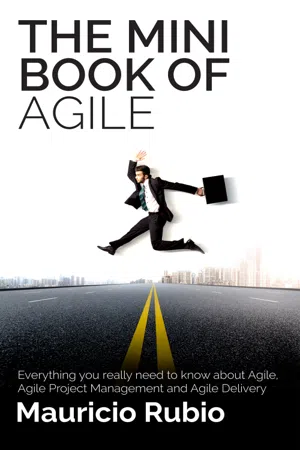
- 50 pages
- English
- ePUB (mobile friendly)
- Available on iOS & Android
The Mini Book of Agile
About this book
Learn all about Agile, Agile project management, and Agile Delivery to put Agile into practice at work and in your personal projectsKey Features• Explore the key concepts of Agile development, Agile project delivery, and Agile project management• Study the different Agile concepts such as user stories, story points, epics, and product backlog• Understand why Agile is different from traditional project delivery and other methodologiesBook DescriptionThink of this book as Agile for Dummies (or Agile for anyone and everyone). This Agile book will allow you to master the most important concepts of Agile development, Agile project delivery, and Agile project management. This mini book has been designed to enable you to manage your projects in an Agile way.This mini book will walk you through the fundamentals, principles, and key concepts of Agile, Agile project management, and Agile Delivery.The book includes valuable resources, graphics, and examples that will allow you to grasp the key essence of Agile, Agile rituals, Agile practices, Agile concepts, and the key differences between Agile and traditional project management.After reading this book, you will have a thorough understanding of Agile and how to put Agile into practice at work and in your personal projects.What you will learn• Review the background and function of Agile and its advantages• Encounter the differences between Agile and Waterfall• Explore Agile principles, culture, and roles• Explore fundamental concepts, Agile artifacts, rituals• Become familiar with some important Agile toolsWho this book is forThis book is for anyone who wants to learn the fundamentals, principles, and key concepts of Agile, Agile project management, and Agile Delivery. No prior Agile experience or knowledge is necessary.
Frequently asked questions
- Essential is ideal for learners and professionals who enjoy exploring a wide range of subjects. Access the Essential Library with 800,000+ trusted titles and best-sellers across business, personal growth, and the humanities. Includes unlimited reading time and Standard Read Aloud voice.
- Complete: Perfect for advanced learners and researchers needing full, unrestricted access. Unlock 1.4M+ books across hundreds of subjects, including academic and specialized titles. The Complete Plan also includes advanced features like Premium Read Aloud and Research Assistant.
Please note we cannot support devices running on iOS 13 and Android 7 or earlier. Learn more about using the app.
Information
- Adaptive software development (ASD)
- Agile modeling
- Agile unified process (AUP)
- Disciplined agile delivery
- Dynamic systems development method (DSDM)
- Extreme programming (XP)
- Feature-driven development (FDD)
- Kanban
- Lean software development
- Rapid application development (RAD)
- Scrum
- Scrumban
- Customer satisfaction by early and continuous delivery of useful software.
- Welcome changing requirements, even late in development.
- Working software is delivered frequently (weeks rather than months).
- Close, daily cooperation between business people and developers.
- Projects are built around motivated individuals, who should be trusted.
- Face-to-face conversation is the best form of communication (co-location).
- Working software is the principal measure of progress.
- Sustainable development, able to maintain a constant pace.
- Continuous attention to technical excellence and good design.
- Simplicity - only build what is really essential.
- Self-organizing teams.
- Regular adaptation to changing circumstance.
Table of contents
- Chaper 1: Introduction
- Chapter 2: What is Agile?
- Chapter 3: Why go Agile?
- Chapter 4: How it all began
- Chapter 5: The Different Agile Methodologies
- Chapter 6: Agile Principles
- Chapter 7: The Agile Culture
- Chapter 8: Agile Roles
- Chapter 9: Agile Concepts
- Chapter 10: Agile Artifacts
- Chapter 11: Agile Rituals
- Chapter 12: Agile Tools
- Chapter 13: Agile vs. Waterfall
- Chapter 14: Agile FAQs
- Chapter 15: Agile Myths
- Chapter 16: The Agile Knowledge Base | AgileKB.com